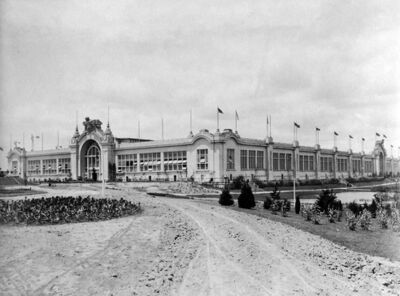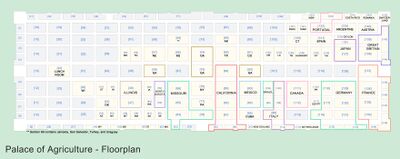Palace of Agriculture
 | |
| Location | Agriculture Area |
|---|---|
| No. of Buildings | 1 |
| Construction | |
| Construction Cost | $529,940 ($16 million in 2021) |
| Architecture | |
| Architect | Emmanuel Lewis Masqueray |
| Dimensions | 546' x 1,660' |
 | |
The Palace of Agriculture was the largest building at the St. Louis World's Fair and the most immense ever built for an Exposition. Its area was the size of 10 football fields and its height was as tall as an eight story building. The Agricultural structure design departs materially from the general ornate style of the other Exposition Palaces, since it was not near the Main Picture.
Description[edit | edit source]
Former President Thomas Jefferson believed that for democracy to flourish, American would do so as a nation of gentlemen farmers. Though in obvious contrast to the industrial and technological `message', that the Fair promoted, the Palace of Agriculture was a testament to Jefferson’s dream of an agrarian society. Since the United States was still mainly an agricultural nation (especially the farm-rich Midwest), the Palace of Agriculture showcased the breadbasket of American production, hence its enormous scope.
Built by Caldwell & Drake of Columbus, Indiana; the Palace of Agriculture housed twenty three acres of exhibits and 10,000 exhibitors. Masquerey’s design was subdued and used sculpture to enhance and not overload adornments on his facades. Masquerey stated “The essence of good design is that a building reflect the purpose for which it was intended.”
A walk of three-quarters of a mile was required to simply pass around it. The palace was sectioned into 148 blocks and contained elaborate exhibits from fifteen countries and forty-two states. Some exhibits within the Palace were complete with roofs of their own while others were walls only. On the east side of it's exterior was planted the largest rose garden in the world, covering 10 acres and displays 1,000,000 blooms.
Within the huge edifice, 170,000 square-feet of space was used to display dazzling showcases of farm products: corn, tobacco, wheat, sugar, etc. There were contests and plenty of produce and drink to sample and purchase. The palace also set aside 30,000 square-feet to house the latest technology in butter, cheese-making and pasteurization as well as recent federal regulation of food processing. A full-sized working dairy plant provided milk and cheese for bakeries and a meat plant showcasing the latest humane slaughter facilities.
The Palace of Agriculture was so large and with over 10,000 exhibitors, if one took in all the exhibits in the huge building alone, one would walk nine miles. 15,000 feet of space was devoted to corn alone.
Around the fair, camera could be carried and pictures taken everywhere except in the Agriculture Building. The photographing rights to that building are strictly reserved by the official photographer.
In the Palace of Agriculture, there are 147,250 panes of glass, all 18 x 25 inches.
Though exhibitors were encouraged to display their produce and wares with creative flair, some needing an edge to attract the massive amount of fairgoers designed and created unique and bizarre displays, many which were quite humorous.
Notable Exhibits[edit | edit source]
The Missouri exhibit occupied prominent position at the main entrance of the palace on the main aisle. Its façade was artistically made out of grains and grasses, illustrating a series of thirty pictures contrasting the old and new methods in agriculture. its centerpiece was a forty-five foot tall Missouri Corn Palace, part of an exhibit by five corn producing Midwestern states.
Mississippi showed a special cotton exhibit, including the 35-foot statue of "King Cotton."
Minnesota exhibited a refrigerated nine by twenty foot butter sculpture of Father Hennepin's discovery of the St. Anthony Falls.
France displayed a giant wine cask.
Outside Displays[edit | edit source]
On its northern edge, The Palace of Agriculture housed another engineering masterpiece, the Floral Clock.
Near the palace, an impressive collection of windmills (renamed- aerometers), occupied several acres upon Agricultural Hill. This showcased harnessing the power of the wind for agricultural uses, wind-powered irrigation, water pumping, corn shelling and grinding, to name a few, were shown.
